PORK CUTTING
Halving is done immediately after the animal has been dressed and every effort should be made to saw the carcass into equal sides through the centre of the backbone. The side to be cut should be laid on the cutting table with the inside up (Figs 93, 94 and 95).
| 92. On-the-rail boning of entire beef side. Removing strip loin together with rump | 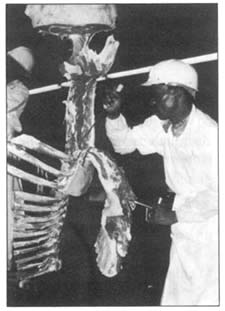 |
The primal cuts of pork are: ham, fore-end or forequarter, loin and belly.
Hind foot. The hind foot is removed by sawing through the hock joint at a right angle to the long axis of the leg (Fig. 96).
Ham. The ham may be removed in several ways to make either long-cut or short-cut hams. One procedure (short-cut) is to locate the division between the second and third (or the third and fourth) sacral vertebrae and saw perpendicularly to the long axis of the ham (Fig. 97). After the bone has been severed with the saw, the knife is used to complete the removal of the ham. The ham is further trimmed by removal of the tail bone on one side and the flank on the other side. Commonly a skinned ham is produced by removal of three-fourths of the skin and fat from the rump end (Fig. 98). For the production of special cured dried hams the skin is left on (Fig. 99).
93. The pork carcass and its bones
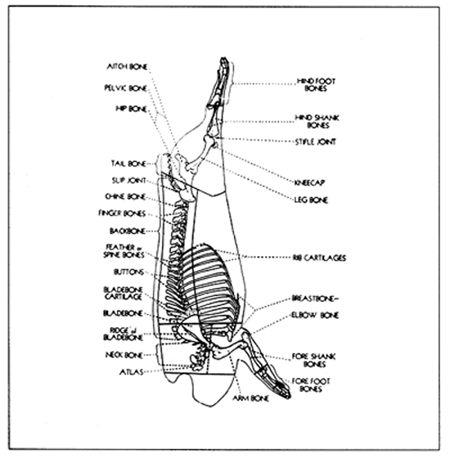
94. The pork carcass and its cuts
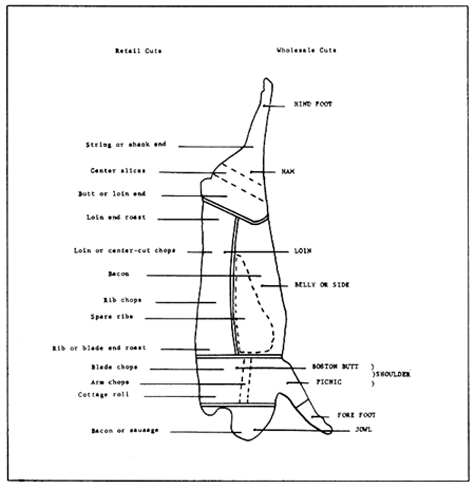
| 95. Pork carcass split into left and right side | 97. Short cut of ham |
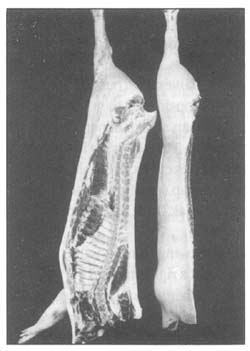 |
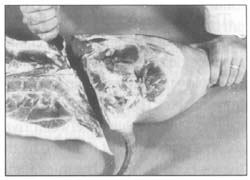 |
| 98. Removing skin and fat from the rump end of the ham | |
| 96. Severing the hind foot | 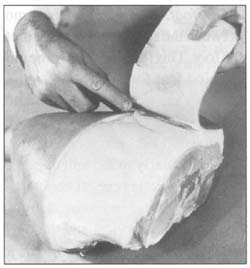 |
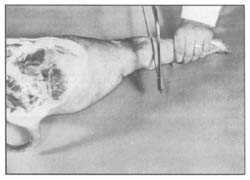 |
|
| 99. Pork leg cut into ham, shank and foot | |
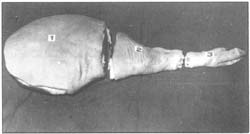 |
The cutting procedure of the ham is as follows. Remove tail bone and aitch bone and cut the rump off. Peel back the rind and associated fat to expose the topside muscle on the interior side of the leg. Separate the topside by following the natural seam between it and the silverside (outside portion of leg) and thick flank (front position of leg). The topside can then be sliced into steaks. This produces between five and six lean steaks depending on the thickness and weight required by the customer. The next step is to remove the leg bone (femur). The thick flank (knuckle) is cut from the silverside by following the natural seam. Remove the kneecap (patella) and the internal fat deposits before further preparation of the thick flank, e.g. for diced pork or steaks.
Forefoot. The forefoot is removed by sawing through the junction between the foreshank and the forefoot bone at a right angle to the length of the foot. This foot contains some muscle and is therefore more desirable than the hind foot for food.
Fore-end. Considerable variation exists as to where the fore-end is removed. Generally one to three ribs are left on the pork fore-end. Locate the division between the third and fourth ribs from the head end and saw perpendicularly to the length of the backbone. The fore-end is trimmed of the hock which is cut off about halfway up the leg and about two-thirds of the skin and fat is removed from the butt or top end. Additionally the neckbone (all cervical and three thoracic vertebrae) and the jowl or cheek meat are removed (Fig. 100). The jowl is removed by a straight cut parallel to the cut that separates the fore-end from the side just behind the site where the ear was removed (Fig. 101). The fore-end may be divided into two cuts (spare-rib, also called blade Boston, and hand, also called arm picnic) by sawing just below the exposed lower end of the blade-bone parallel to the top of the shoulder (Fig. 102). The spare-rib can be sliced into steaks or used as a roast. It can easily be made into a boneless cut by removing the corner of the blade-bone.
Besides this method some other ways of cutting and boning the pork foreend exist. In order to obtain boneless cuts (shoulder and neck-end) from the fore-end the following technique is recommended. Seam the shoulder carefully from the rest of the side, leaving the rind and associated fat behind. Release the under-blade steak and remove the blade-bone (scapula) and the shoulder-bone (humerus). Separate the main muscle block from the smaller group. The smaller group, after trimming the fat off, can be used for dicing. The main shoulder block should be trimmed of excessive connective tissue. It can be separated further into the blade and feather muscles and the main shoulder muscle. These can then be sliced into a number of boneless steaks. The group of muscles on either side of the spinous processes of the neckbone and the two or three following segments of the backbone is called the neck-end. The neck-end is loosened from the backbone and after trimming off excessive rind, fat and any adhering ragged edges it can be cut into attractive steaks.
| 100. Pork shoulder (middle), jowl or cheek meat (left), neck bone (right below) | 102. Dividing the shoulder into two cuts (left, spare-rib; right, hand or arm picnic) |
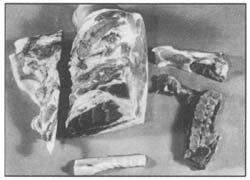 |
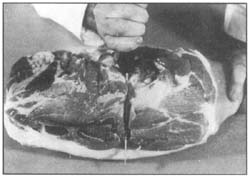 |
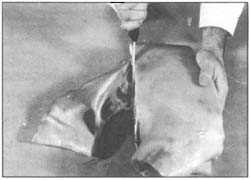 |
101. Removing the jowl or cheek meat |
Lion. The middle or centre section of the pork side is divided into loin and belly by a straight cut from the edge of the tenderloin muscle on the ham end through a point on the front rib tight against the protruding edge of the split backbone (Fig. 103). The fat back (skin and excess fat) is removed from the loin so that a complete fat cover about 0.5 cm thick remains. Starting along the backbone side at the shoulder end, cut and lift the fat over the curve of the loin muscles without cutting into the lean (Fig. 104). The loin can be roasted whole, cut into smaller roasts or cut into chops. Shoulder, rib, loin and sirloin chops are made from the loin. Chops for broiling or frying should be cut 1.3–1.9 cm thick. Thicker chops may be made and a pocket cut into them for stuffing (Fig. 105).
Belly. Separate the spare-ribs from the belly by cutting closely underneath the ribs beginning at the flank end (Fig. 106). Prepare the bacon side from the belly by removing any thin or ragged pieces of lean. Turn the belly over and remove the lower edge with a straight cut just inside of the teat line. Trim the flank edge of the belly to square the whole piece to prepare it for curing.


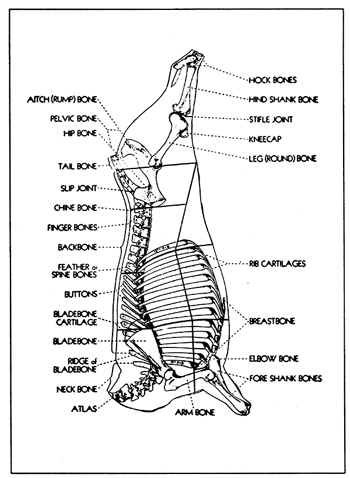
This is really nice to know. I hope it will be successful in the future. Good job on this and keep up the good work.
I am sure this post has touched all the internet people, its really really nice paragraph on building up new webpage.|
I’m really impressed with your writing skills as well as with the layout on your blog. Is this a paid theme or did you customize it yourself? Either way keep up the nice quality writing, it is rare to see a nice blog like this one nowadays..
Hi, I do think this is an excellent blog. I stumbledupon it 😉 I will come back once again since i have book-marked it. Money and freedom is the greatest way to change, may you be rich and continue to help other people.
By the Way, If you are looking to improve your web site with additional useful, interesting, internet search engine friendly content to create huge traffic and more profit, than I highly recommend you to visit this web site to along with the most vauable Article Marketing Tools. All the best – Ivelisse